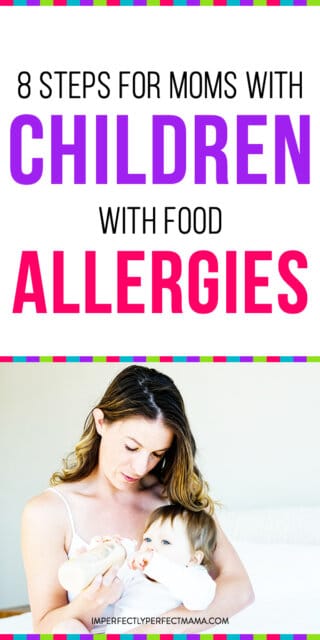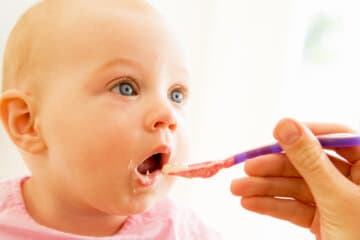So I think it’s important to start off with a little back story about our food allergy journey.

My daughter was about 2 months old when we first started noticing that she might have a milk allergy.
She would throw up most of her bottles and then started having eczema as well.
We took her to the doctor and the doctor said what we were seeing was normal and that it was nothing to be concerned about.
Well, that wasn’t a good enough answer for this mama!
If there’s one thing I’ve learned through our allergy journey it’s to advocate for your child no matter how hard it might be.
Now we were on to Plan B, see a different doctor.
The next doctor we saw took our concerns seriously and came up with a plan for us.
They do not typically allergy test infants as they say it often isn’t accurate, so we just eliminated dairy from her diet and planned to test later.
Fast forward to when she was a year old and we could finally do allergy testing and we found out she was allergic to milk and eggs.
The eggs threw us for a loop as we weren’t expecting that allergy.
I’ve learned a lot along this food allergy journey that we’ve been on and I know how overwhelming it can be at first.
I wanted to share a little advice for any mamas dealing with this right now so here are 8 simple steps you can take at the beginning of your food allergy journey.
1. Learn the Difference Between Intolerance and Allergy
There is a chance that your child could just have an intolerance and not a full-blown allergy.
It’s important to figure out which it is because an allergy is going to be more serious than an intolerance.
This is where allergy testing comes in. You want to get tested so you can know if your child is actually allergic or not.
And please don’t ever say your child is allergic to anything when they aren’t or you don’t know for sure that they are. This promotes people seeing food allergies as not as serious as they really are.
2. Find an Allergist That You Mesh Well With
Just like it was important for us to find a pediatrician that listened to our concerns, it’s equally as important to find an allergist that you mesh with.
You want an allergist who is going to listen to your concerns and follow your child’s lead even if one test comes back negative.
Do your research and know what you want out of your allergist appointment and if something doesn’t feel right with that doctor then find a new one.
3. Learn what Allergy Testing Entails
There are two different ways to test for allergies.
The most common way is the skin prick test. This is where the allergist will prick the skin on your child’s back and more or less insert some of that allergen into their skin and see if they react. It sounds painful but our toddler has never seemed to mind it.
The other way to test is through a blood test. This is often done after the skin test to confirm an allergy, for instance when my daughter’s skin test showed she was allergic to milk they also did a blood test just to make sure.
There are times when a skin test can show a false negative or positive but from my understanding the blood test is almost always accurate.
All of this being said you just need to be prepared for what all allergy testing entails.
4. Advocate for Your Child
The main thing you need to know as a mother of a child with food allergies is that you are your child’s biggest advocate.
Your child doesn’t yet know how to voice all of their needs so that responsibility falls on you.
Trust your mom gut and push the doctors until you get some answers. You know your child best and you know what is and isn’t normal for them so don’t settle for results that you aren’t completely satisfied with.
5. Find Alternatives That are Safe for Your Child
This is the fun part (she says sarcastically).
The top 8 allergens are milk, eggs, fish, shellfish, tree nuts, peanuts, wheat, and soy and a lot of those are in EVERYTHING!
We had a dairy allergy, a milk allergy and a gluten intolerance so you can imagine how tricky that made things and I know some children deal with a lot more allergies.
I know it is going to feel so overwhelming at first but you just have to take a deep breath. The good thing is that companies are required to say if their product contains one of the top 8 allergens.
The nutrition label will say something like “this product contains milk.” That is a great way to know what your child can’t have. I always recommend double-checking ingredients just in case.
It’s also really easy to get caught up in the specialty “allergy-free” foods but it’s really expensive to buy into that hype. If you are looking to save money then your best bet is to make safe alternatives at home.
There are also plenty of allergy-friendly snacks out there that are just regular snacks.
The point is, allergen-free food doesn’t have to be expensive or complicated. Find regular foods that don’t contain your child’s allergens and skip the rest.
6. Educate Yourself on How to Properly Tend to an Allergic Reaction
You should discuss with your doctor what you should do in the event of an allergic reaction.
There are different types of reactions like rashes, swelling and anaphylaxis and you need to know how to tend to each one of them.
Should you give Benadryl? When do you administer the Epipen? What do you do after that?
These are all questions you should ask your doctor.
It’s a good idea to type that out and keep it with your child’s emergency allergy medication that way anyone can properly help them during an emergency.
7. Be Prepared to Repeat Yourself One Thousand Times
You are going to have to repeat your child’s allergens to every single person that ever cares for your child.
That includes church workers, teachers, daycare workers, babysitters, family, friends, and even random people.
You have to be prepared to let people know that your child’s allergies are serious and they need to be taken seriously.
If someone isn’t willing to listen to what you are saying they don’t trust them to have your child’s best interest in mind.
8. Know That is Will Be Overwhelming at First
I know this season is tough but I promise it gets better. Once you learn the foods your child can and can’t eat, you’ll get into a new normal and everything will calm down.
The most important thing is to not overwhelm yourself with too many options and too much research. Do what you need to for your child and you can slowly find more options of things for them to eat.
You’ve got this!
Does your child have food allergies? What advice would you give moms just starting on this journey?




Leave a Reply